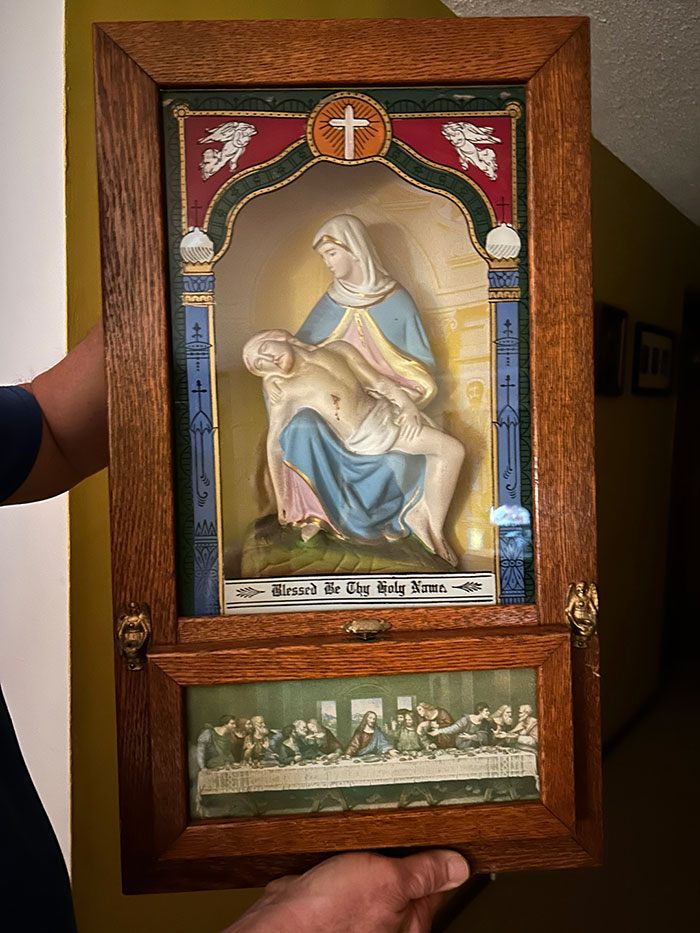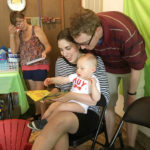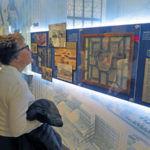
This antique is “The Holy Name Altar and Sick Call Outfit” Barb Arland-Fye received as a gift.
By Barb Arland-Fye
Editor
More than a century ago, a self-described Catholic art company, Koenig Bros., received a patent for “The Holy Name Altar and Sick Call Outfit,” one of which now resides in my home. The small, oak-framed cabinet features a chalkware figure of the Pietà in a niche of the cabinet behind a glass face painted like stained glass along the borders.

An aged booklet describes the contents of the Communion set inside a separate compartment under the statue. It consists of a crucifix, a heavily nickel-plated and polished plate “for the absorbent cotton and salt or bread crumbs for absorbing the oil which adheres to the priest’s fingers.” It also contains “a spoon used in administering the obulation water to the Communicant,” a holy water bottle, two rubrical wax candles and “two hemstitched linen clothes, one for the breast of the Communicant and one for the fingers of the priest.” Also included is “absorbent cotton to be used by the priest in the anointing of the sick.”
The glass front of the Communion set compartment depicts “a copy of Leonardo di Vinci’s world famous painting of the ‘Last Supper.’ Thus the lower part of the Altar portrays the first step in the passion when Judas prepared to betray Our Lord and the upper part represents the last stage when the agony of Our Saviour is restored to His Mother.”
A close relative chose to give the altar/wall shrine to someone in our extended family whom he thought would appreciate it. The Pietà is one of my favorite depictions of our Blessed Mother, so I accepted the gift with gratitude.
Unfamiliar with the concept of the Sick Call Altar, I googled the title of the Koenig Bros.’ masterpiece and found several for sale online. I found a brief, helpful description of the Sick Call Altar Box on the website of the Archbishop John C. Favalora Archive & Museum, St. Thomas University Library, Miami Gardens, Florida:
“It was customary for Catholic families to have a Sick Call Altar Box at home during the late 1800s and early 1900s. Priests used it to administer the Sacrament of Last Rites (now called anointing of the sick) to a seriously ill or dying person. The boxes usually contained a bottle of holy water, a silver tray with the letters “IHS,” candles, candleholders, a crucifix, and a cruet for holy oil. “IHS” are letters that stand for the Greek words for Jesus Christ, and “Viaticum” is Latin for “provisions for a journey to the afterlife.”
The booklet tucked inside my Sick Call Altar describes this “devotional work of art representing the 13th Station (of the Cross)” … as a religious object reminding the devout Catholic of the beauties and consolations of his religion” that “should find a welcome in every good Catholic family.” The Catholic Company said the tradition for Catholic families to own a Sick Call Altar is “making a comeback.”
As I view my Holy Name Altar Sick Call Outfit, I will contemplate an excerpt from a 13th Station of the Cross reflection I found on the Vatican News website (https://tinyurl.com/4fjxws8h):
“May we, too, draw near the body of Jesus, lowered from the cross and held in his Mother’s arms. Let us approach ‘not by walking but by believing, not with physical steps but with the free decision of our heart.’ In this lifeless body we see ourselves as members of Christ, his limbs, wounded and suffering, yet safe in the loving embrace of our Mother. But let us also see ourselves as held in these motherly arms, firm yet gentle. The open arms of the Church, our Mother, are like the altar which offers us the Body of Christ. There we become Christ’s mystical Body.”
(Contact Editor Barb Arland-Fye at arland-fye@davenportdiocese.org)











